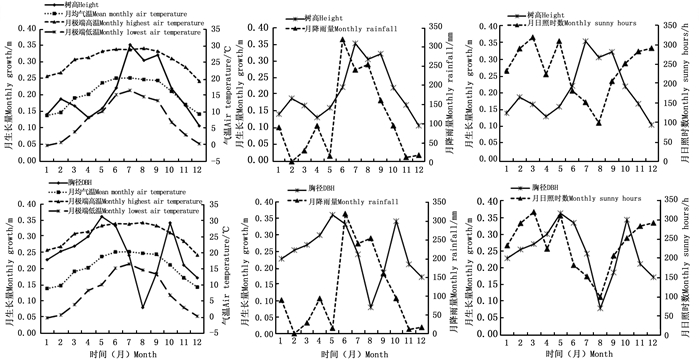-
西南桦(Betula alnoides Buch.-Ham. ex D. Don) 是我国热带、南亚热带地区的一个珍贵乡土阔叶树种,其树干通直圆满,生长迅速,材质优良,经济价值高,亦是我国西南部云南、广西等省区水源涵养林的主要树种之一,具有重要的生态价值[1]。西南桦在云南、广西等省区广泛栽培,经过近20年的推广种植,其人工林面积已逾15万hm2,成为我国热带、南亚热带地区的一个主要造林树种[2]。
随着无性系林业在我国的兴起,西南桦扦插[3]和组培[4-5]等无性繁殖技术的突破,使西南桦有性选育和无性利用成为可能。从前期营建的种源/家系试验林、优良种源地天然林或利用优良种源营建的人工林内选择优树,通过组培等将其无性系化,建立无性系测定林予以评价,进而示范推广,是当前推广应用西南桦良种的快速有效途径之一。近5年来,中国林业科学研究院热带林业研究所、热带林业实验中心与各地林业企事业单位合作营建了无性系测定林,并进行了早期评价[6-7]。生态适应性是选择育种过程中必选性状[8],树木对不同环境的适应必然会引起其生长节律的变化[9],对生长节律进行研究有助于揭示树种生态适应性[10-11],而对种源、家系或无性系生长节律的研究,还有助于开展这些种质材料的早期评价[12-13]。利用生长节律与造林地气候因子变化相匹配的种质材料造林往往更有成效[14]。有关树木生长节律的研究多为苗期观测[12-13, 15-17],有关幼林生长节律研究的报道相对较少,如郭文福等[18]对米老排(Mytilaria laosensis Lec.)、曹健康等[19]对光皮桦(Betula luminifera H. Winkl.)及Lukkarinen等[13]对西伯利亚落叶松(Larix sibirica Ledeb.)和兴安落叶松(L. gmelinii (Rupr.) Kuzen.)幼林生长节律进行了观测报道。关于西南桦生长节律方面的研究未见报道。
滇西地区是西南桦的首要产区,据初步统计,目前其西南桦人工林面积占全国总面积的70%以上。西南桦在该地区木材生产与生态建设中发挥着重要作用。本研究以滇西地区西南桦无性系幼林为对象,比较不同无性系的生长表现,探讨不同无性系的高径生长节律及其与主要气象因子变化的相关性,增进对西南桦生长规律的认识,为滇西地区西南桦无性系选育、速生丰产林营建及经营奠定技术基础。
HTML
-
试验地位于云南省腾冲县荷花乡尖山村尖山国有林区(98°28′50″ E,25°03′28″ N)。该地属中亚热带山地季风气候,年均气温14.6℃,≥10℃年积温4 640℃,最热月平均气温19.5℃,最冷月平均气温7.5℃,极端最高气温30.2℃,极端最低气温-4.3℃;年均降水量1 500 mm,干湿季分明,6-9月为雨季;年日照时数2 167 h,霜期110~145 d;生长节律观测期内各月气象资料详见表 1。试验地海拔1 680~1 750 m,地处南坡中坡位,坡度12°。土壤为砂质壤土,土层厚度≥1 m,土壤肥力中等,种植前为杉木(Cunninghamia lanceolata (Lamb.) Hook.)采伐迹地。
指标Factors 观测时间(年-月) Observation time (Year-Month) 2014-06 2014-07 2014-08 2014-09 2014-10 2014-11 2014-12 2015-01 2015-02 2015-03 2015-04 2015-05 月均气温Mean monthly air temperature/℃ 20.2 20.3 19.8 19.5 16.2 12.2 9.3 8.9 9.8 14.2 15.3 18.8 月最高气温
Monthly highest air temperature/℃29.0 28.9 29.3 28.4 26.2 23.6 19.3 20.8 21.9 25.9 26.5 28.4 月最低气温
Monthly lowest air temperature/℃15.2 16.5 14.6 13.4 6.8 3.0 0.3 -0.2 0.7 3.9 8.3 10.1 月降水量Monthly rainfall/mm 319.7 240.2 254.2 160.2 94.1 11.3 17.1 89.5 0.2 29.0 93.9 14.8 月日照时数Monthly sunny hours /h 181.8 152.5 99.1 206.5 252.2 283.3 291.6 232.9 290.7 319.8 224.1 309.9 注:降水量和日照时数参照试验地附近腾冲市荷花乡气象观测站的观测数据;气温数据则根据观测站的数据进行推算,海拔每升高100 m,气温下降0.6℃。
Note: Data of monthly rainfall and sunny hours were obtained from the meteorological observation station near the experimental site in Hehua Town, Tengchong City; Data of air temperature were calculated with data from the meteorological station according to the formulae: T2 = T1-(A2-A1)×0. 6/100, where T1 and T2 are air temperature (℃), and A1 and A2 are altitude (m) of the experimental site and meteorological station, respectively.Table 1. Data of main meteorological factors during growth rhythm observation (2014—2015)
-
西南桦无性系测定林营建于2011年,参试20个无性系均来自广西凭祥大青山种源的人工林优树[6],采用随机区组试验设计,5株小区,5次重复,株行距2 m×4 m,试验林面积约0.5 hm2。采用组培苗造林,于4月上旬沿等高线带状整地、挖穴,穴规格40 cm×40 cm×50 cm,每穴施1 kg钙镁磷肥作为基肥,7月中旬种植。种植后第2年开始,每年6月和10月进行常规抚育,连续抚育3年。
-
2014年5月至2015年5月,每月15日采用围尺和塔尺测定每株幼树的胸径和树高。为保障测量的准确性,用红色油漆标记每株幼树的胸高位置(主干上距离地面1.3 m处),而且胸径、树高的测量分别由专人实施。
-
采用最后1次观测数据,应用SPSS19.0软件,选用GLM模型,参照Wu等[20]的方法对20个西南桦无性系的胸径、树高生长数据进行方差分析和多重比较。依据20个西南桦无性系的生长表现,利用欧氏距离进行聚类,划分不同生长类型。应用软件ForStat 2.1进行有序样本聚类分析[21],划分各类型西南桦无性系树高、胸径生长阶段,揭示其生长节律特征。由于生长观测开始于5月,结束于翌年5月,进行有序样本聚类分析时,考虑到数据分析上的方便,将月份数据进行了平移,从而满足数据按照1月至12月排序。西南桦无性系生长过程与主要气象因子相关性分析应用SPSS19.0完成,相关系数采用Pearson系数。
2.1. 试验材料
2.2. 生长观测
2.3. 数据处理
-
方差分析结果表明:不同无性系间生长表现差异极显著(P < 0.01)。近4年生时,20个无性系的平均树高为(7.03±0.10) m,年均生长量为(1.84±0.03) m;Q3无性系的树高生长表现最佳,比平均水平高17.35%;A12无性系表现最差,比平均水平低11.10%。20个无性系的平均胸径为(7.90±0.11) cm,年均生长量为(2.06±0.03) cm;A10无性系的胸径生长最快,比平均胸径高20.63%;FB4+无性系的胸径生长最慢,比平均胸径低15.32% (表 2)。
无性系
Clones树高
Height /m树高年均生长量
Annual height growth/(m·a-1)胸径
DBH/cm胸径年均生长量
Annual DBH growth/(cm·a-1)B1 7.21±0.29abcde 1.88±0.07abcde 8.13±0.39bcde 2.12±0.10bcde B3 7.19±0.59abcde 1.88±0.15abcde 9.07±0.39ef 2.37±0.10ef A10 8.11±0.22de 2.12±0.05de 9.53±0.22f 2.49±0.06f FB4 6.80±0.32abc 1.78±0.08abc 7.18±0.33abc 1.88±0.08abc A12 6.25±0.42a 1.63±0.10a 6.93±0.42ab 1.81±0.11ab A6 6.64±0.34ab 1.73±0.09ab 7.00±0.71abc 1.83±0.18abc Q1 7.20±0.27abcde 1.88±0.07abcde 7.72±0.18abcd 2.02±0.05abcd A7 6.77±0.26abc 1.77±0.06abc 8.03±0.26bcde 2.10±0.07bcde A5 7.05±0.42abcde 1.84±0.11abcde 8.12±0.40bcde 2.12±0.10bcde Q3 8.25±0.38e 2.15±0.10e 8.66±0.04def 2.26±0.01def 1-202 7.22±0.54abcde 1.88±0.14abcde 7.74±0.27abcd 2.02±0.07abcd 102 6.52±0.34ab 1.70±0.09ab 8.17±0.21bcde 2.13±0.05bcde Q4 7.66±0.31bcde 2.00±0.07bcde 8.30±0.20cde 2.17±0.05cde A9 6.99±0.36abcd 1.82±0.09abcd 7.49±0.45abcd 1.96±0.11abcd A2 6.41±0.32ab 1.67±0.08ab 7.15±0.23abc 1.87±0.06abc B2 6.57±0.16ab 1.71±0.04ab 7.84±0.34abcde 2.05±0.09abcde Q2 7.93±0.04cde 2.07±0.01cde 8.07±0.25bcde 2.11±0.06bcde C5 6.70±0.50abc 1.75±0.13abc 7.40±0.16abcd 1.93±0.04abcd FB2 6.75±0.35abc 1.76±0.09abc 7.92±0.34abcde 2.07±0.09abcde FB4+ 6.50±0.27ab 1.70±0.07ab 6.69±0.48a 1.75±0.12a 注:小写字母表示Duncan多重比较结果,无性系间具相同字母表示差异不显著(P≥0.05),字母不同表示差异显著(P < 0.05)。
Note: Lowercase letters refer to results of Duncan’s multiple range tests; paired clones with the same letter are not significantly different (P≥0.05), while those without the same letter are significantly different (P < 0.05). DBH means diameter at breast height.Table 2. Growth performance of twenty Betula alnoides clones in western Yunnan (near four years old)
依据树高、胸径2个生长指标对20个无性系进行聚类分析,将其分为3类(表 3)。第Ⅰ类生长最快,包括B3、A10、Q3、Q4、Q2等5个无性系,结合表 2可以看出,其树高和胸径年均生长量多在2 m和2 cm以上,仅B3号无性系树高年均生长量略低于2 m;第Ⅱ类生长次之,包括B1、Q1、A7、A5、1-202、102、A9、B2、FB2等9个无性系,其胸径年均生长量多高于2 cm (A9略小于2 cm),而树高年均生长量未达到2 m;第Ⅲ类生长最慢,包括FB4、A12、A6、A2、C5、FB4+等6个无性系,其年均树高和胸径生长量均在2 m和2 cm以下。
类型
Types无性系Clones 树高Height 胸径DBH 平均值
Mean/m年均生长量
Annual growth /(m·a-1)平均值
Mean/cm年均生长量
Annual growth/(cm·a-1)Ⅰ B3、A10、Q3、Q4、Q2 7.83 ± 0.19 2.04 ± 0.05 8.73 ± 0.26 2.28 ± 0.07 Ⅱ B1、Q1、A7、A5、1-202、102、A9、B2、FB2 6.92 ± 0.09 1.80 ± 0.02 7.91 ± 0.08 2.07 ± 0.02 Ⅲ FB4、A12、A6、A2、C5、FB4+ 6.55 ± 0.08 1.71 ± 0.02 7.06 ± 0.10 1.85 ± 0.03 Table 3. Classification of Betula alnoides clones and growth performance of each type in western Yunnan
-
从图 1可看出:3种类型西南桦无性系树高生长高峰出现在7—9月,尽管8月生长速度略微下降;而在4月和12月有2个生长低谷,且12月为一年中西南桦生长最慢的时期。
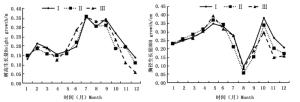
Figure 1. Monthly growth dynamics of height and diameter at breast height of Betula alnoides clones in western Yunnan (Ⅰ, Ⅱ and Ⅲ stand for different clone types)
依照有序聚类分析法,将西南桦无性系的树高生长期分为3个阶段,即缓生期、速生期和滞生期(表 4)。3种类型西南桦无性系在各阶段树高生长存在明显差异,如类型Ⅰ在6月中旬进入速生期,于9月中旬结束;类型Ⅱ亦于6月中旬进入速生期,而结束于9月中旬;类型Ⅲ于5月中旬进入速生期,于10月中旬结束。类型Ⅰ在速生期、缓生期内的生长速度与Ⅱ和Ⅲ均差别不大,在滞生期内比类型Ⅲ生长快,但类型Ⅰ的速生期比Ⅱ长1个月,其滞生期比Ⅱ和Ⅲ短1个月。由此可见,树高年生长量最大的类型Ⅰ西南桦无性系在速生期并不具生长优势,其由缓生期转入速生期时增速较慢,而由速生期转入滞生期时,生长速度下降明显比类型Ⅱ和Ⅲ慢,保证了其在更长时间内保持树高生长的优势。
类型
Types缓生期Low-growing stage 速生期Fast-growing stage 滞生期Lag-growing stage 时间(月-日)
Time(month-day)月均增量
Mean monthly growth/m时间(月-日)
Time(month-day)月均增量
Mean monthly growth/m时间(月-日)
Time(month-day)月均增量
Mean monthly growth/mⅠ 01-16~06-15 0.18±0.01 06-16~10-15 0.32±0.02 10-16~01-15 0.17±0.03 Ⅱ 01-16~06-15 0.17±0.01 06-16~09-15 0.32±0.02 09-16~01-15 0.16±0.03 Ⅲ 01-16~05-15 0.17±0.01 05-16~09-15 0.33±0.02 09-16~01-15 0.13±0.05 Table 4. Division of height growth stages for three types of Betula alnoides clones in western Yunnan
-
西南桦无性系胸径生长节律比树高的复杂,而且胸径与树高的月生长动态相关不显著(R2 =-0.006, P≥0.05)。由图 1可知:3种类型西南桦无性系全年的胸径生长均表现出快、慢交替的规律,于5月和10月出现2个胸径生长高峰,8月和12月出现2个生长低谷,且8月为全年胸径生长最慢的时期。
经有序聚类分析,将西南桦无性系的胸径生长期划分为5个阶段,即:缓生期、第1速生期、第1滞生期、第2速生期及第2滞生期(表 5)。类型Ⅰ和Ⅲ于3月中旬进入第1速生期,7月中旬结束,比类型Ⅱ长1个月;3种类型西南桦无性系的第1滞生期均于9月中旬结束,相应地,类型Ⅰ和Ⅲ的第1滞生期比类型Ⅱ少1个月;3种类型的第2速生期、第2滞生期及缓生期均相同,分别为9月中旬至10月中旬、10月中旬至12月中旬、12月中旬至3月中旬。比较3种类型无性系在各阶段的月均生长量可知:在其缓生期、第1速生期和第1滞生期的胸径生长量差别不大,年生长量最大的类型Ⅰ甚至略低于Ⅱ和Ⅲ,而在第2速生期和第2滞生期其生长差异增大,类型Ⅰ的胸径生长明显高于Ⅱ和Ⅲ。总之,生长最快的类型Ⅰ属“慢热”型,第1速生期虽然生长速度比类型Ⅱ和Ⅲ的低,但其持续时间长,而第2速生期生长速度明显比类型Ⅱ和Ⅲ的快,第2滞生期生长速度下降最慢。
类型
Types缓生期
Low-growing stage第1速生期
First fast-growing stage第1滞生期
First lag-growing stage第2速生期
Second fast-growing stage第2滞生期
Second lag-growing stage时间(月-日)
Time(month-day)月均增量
Mean monthly growth/cm时间(月-日)
Time(month-day)月均增量
Mean monthly growth/cm时间(月-日)
Time(month-day)月均增量
Mean monthly growth/cm时间(月-日)
Time(month-day)月均增量
Mean monthly growth/cm时间(月-日)
Time(month-day)月均增量
Mean monthly growth/cmⅠ 12-16~03-15 0.23±0.01 03-16~07-15 0.31±0.02 07-16~09-15 0.15±0.06 09-16~10-15 0.38±0.06 10-16~12-15 0.24±0.03 Ⅱ 12-16~03-15 0.23±0.02 03-16~06-15 0.34±0.02 06-16~09-15 0.14±0.05 09-16~10-15 0.34±0.04 10-16~12-15 0.19±0.02 Ⅲ 12-16~03-15 0.23±0.01 03-16~07-15 0.32±0.03 07-16~09-15 0.14±0.05 09-16~10-15 0.30±0.06 10-16~12-15 0.15±0.00 Table 5. Division of DBH growth stages for three types of Betula alnoides clones in western Yunnan
-
为探讨主要气象因子对西南桦无性系幼林生长节律的影响,分析其树高、胸径月生长量与月平均气温、月降水量、月极端高温、月极端低温及月日照时数等气象因子之间的相关性,结果(表 6)表明:树高月生长量与月日照时数呈极显著负相关(P < 0.01),与月平均气温、月极端低温极显著正相关,与月降水量、月极端高温显著相关(P < 0.05);5个气象因子中,胸径月生长量与日照时数相关性最强,但相关不显著(P≥0.05)。
指标Factors 月均气温
Mean monthly air temperature月降水量
Monthly rainfall月极端高温
Monthly highest air temperature月极端低温
Monthly lowest air temperature月日照时数
Monthly sunny hours月树高生长量Monthly height growth 0.732** 0.701* 0.688* 0.785** -0.733** 月胸径生长量Monthly DBH growth 0.128 -0.152 0.175 0.013 0.434 注:*P < 0.05; **P < 0.01。Note: *P < 0.05; **P < 0.01. Table 6. Relationship between height and DBH growth of Betula alnoides clones and meteorological factors
为了更直观地揭示西南桦生长节律与气象因子月动态变化规律的关系,分别绘制树高、胸径净生长量与各气象因子的月变化折线图(图 2)。由图 2看出:树高月生长量与各气象因子的关系密切,与当月气温、降水量的整体变化相吻合,而与日照时数的变化趋势大致相反。胸径月生长量变化很复杂,与气象因子趋势的变化不甚吻合,不过可以明显看出,从5月至10月,日照时数与胸径月生长的变化趋势一致,推断8月日照时数低是其胸径生长最慢的主要原因。
3.1. 生长表现
3.2. 生长节律
3.2.1. 树高生长节律
3.2.2. 胸径生长节律
3.2.3. 生长节律与气象因子的相关性
-
参试的20个西南桦无性系在云南省腾冲县的生长差异显著,树高和胸径生长分别以无性系Q3和A10表现最佳。通过聚类将20个无性系划分为3个类型,B3、A10、Q3、Q4、Q2等5个无性系属于速生类型,其树高、胸径年均生长量大多超过2 m和2 cm,在滇西地区具有较大的发展潜力。20个西南桦无性系中,仅Q2和Q4在粤西地区(广东省云浮市云安区) 亦表现优良[7],而在广东省云浮市云安区和桂西地区(凭祥、天峨、田林)生长表现优良的无性系FB4和FB4+在滇西地区则属于慢生型[6-7]。由此可见,优良无性系选择有其地域性,在进行无性系大面积推广之前,开展其区域性测试尤为重要。
3种类型西南桦无性系的生长节律基本一致,其幼林树高生长节律与大多数阔叶树种如米老排[14]等相似,呈现“慢-快-慢”的生长过程,其生长期可划分为缓生期、速生期和滞生期3个阶段;而其胸径生长遵循“慢-快-慢-快-慢”规律,生长期划分为缓生期、第1速生期、第1滞生期、第2速生期和第2滞生期5个阶段。本研究中,速生型西南桦无性系的树高生长速度并非在其速生期而在缓生期和滞生期高于其他2个类型,胸径生长速度亦在第1速生期结束后才高于其他类型。由此可见,速生型无性系保持较高生长速度的时间较其他类型长,说明这些无性系的活力强,从而使其年生长量明显高于其他类型无性系。
相关性分析结果显示,西南桦无性系的胸径和树高月生长量的相关不显著,说明二者的生长节律是相互独立的,与光皮桦[19]、印楝(Azadirachta indica A.Juss)[22]等树种类似。西南桦树高生长具1个生长高峰,且持续时间较长(7—9月),4月和12月为生长低谷;西南桦胸径生长有2个生长高峰,分别在5月和10月,有2个生长低谷,分别在8月和12月,8月的胸径生长量明显低于12月,与米老排[18]、光皮桦[19]、印楝[22]等树种明显不同,究其原因,与树种适应性、种植立地差异有关。一方面,西南桦喜温凉湿润气候,而且10—11月(属旱季) 落叶后约半个月即发新叶,虽然12月的月均气温降至10℃以下,但仍能保持生长;另一方面,西南桦喜光,在滇西地区8月份胸径生长量低,与该月日照时数最小有关,因为胸径生长量与日照时数的相关性最强。
-
综上所述,参试的20个西南桦无性系在云南省腾冲县生长表现差异显著,其中,B3、A10、Q3、Q4、Q2等5个无性系生长良好,可在滇西地区推广。3种类型西南桦无性系的生长节律基本一致,均呈现“慢-快-慢”的生长过程,其中,速生型无性系生长较快是因为其比中等和慢生型在更长时间内保持较高的生长速度。西南桦无性系的胸径和树高的生长节律不同步,高生长与气象因子相关显著。因此,为了促进西南桦生长,建议在树高、胸径生长高峰来临之前,在5月初和9月加强抚育,并结合降雨天气进行施肥。

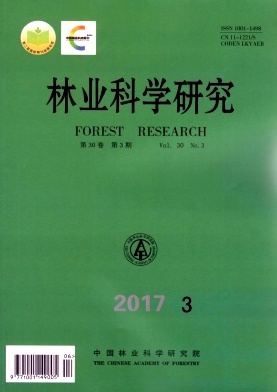


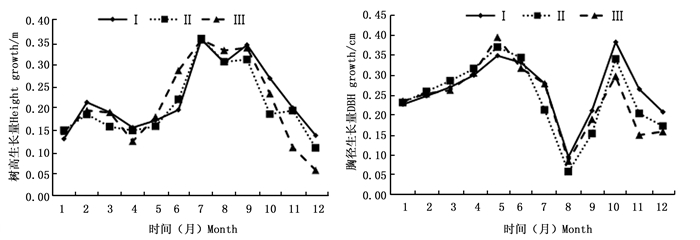

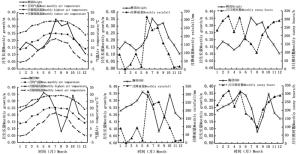
 DownLoad:
DownLoad:
